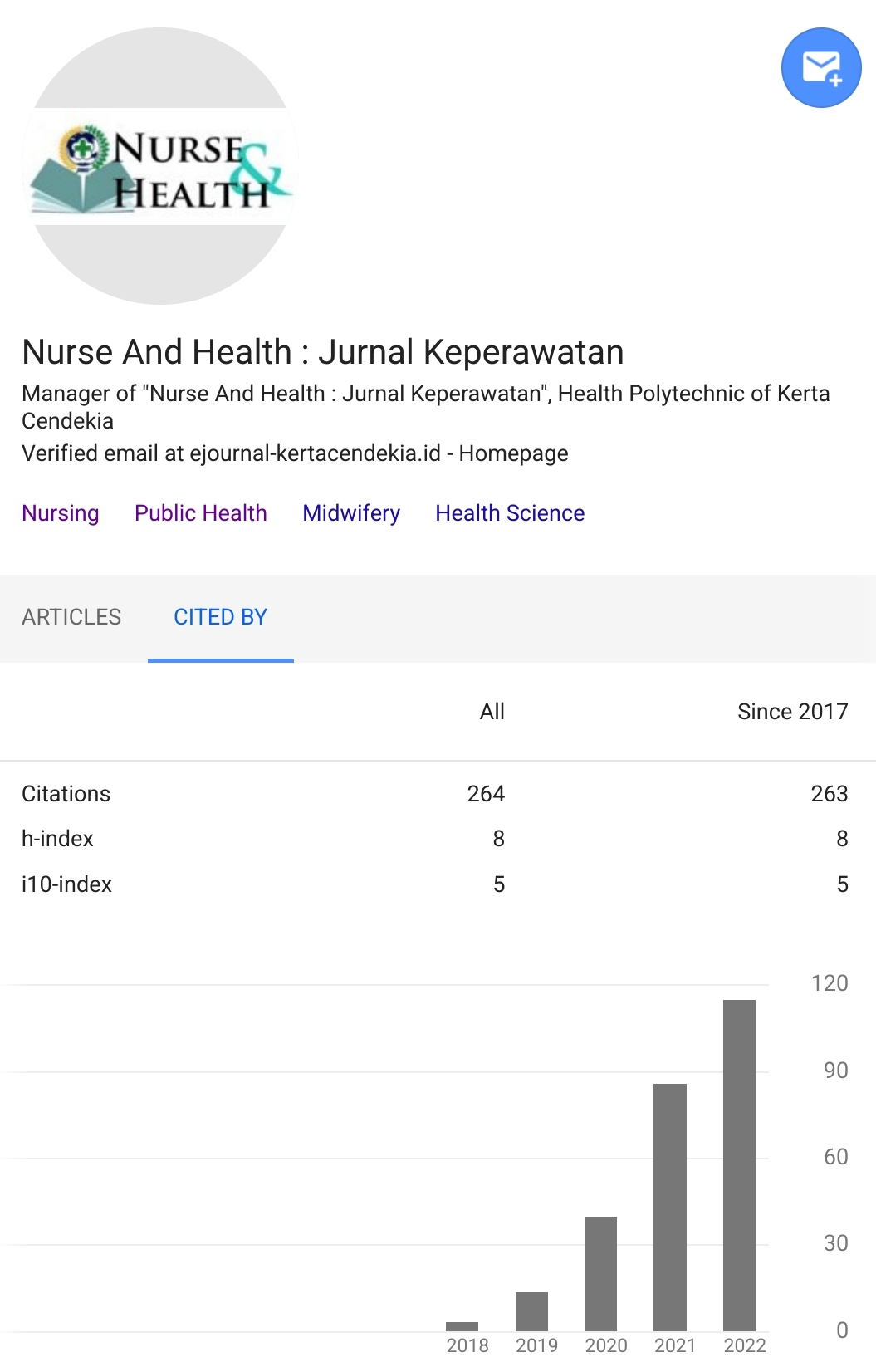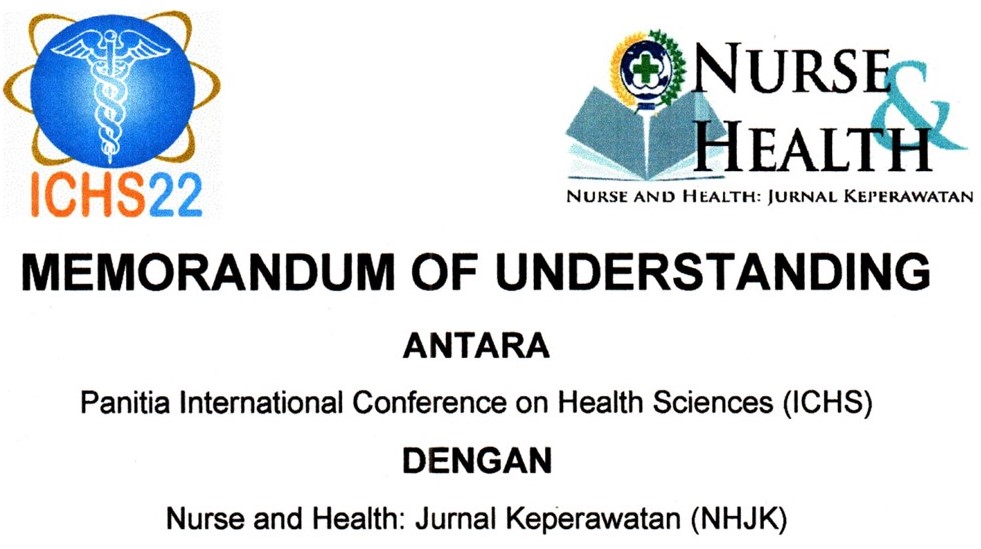ANXIETY OF HEMODIALYSIS PATIENT WITH ACCESS ARTERIOVENOUS FISTULA (AV-SHUNT): A QUALITATIVE STUDY
Abstract
Background: Cannulation is an intervention that inserts a needle through the skin into a blood vessel. Av-shunt is the most recommended access for use in the hemodialysis therapy process. Psychosocial problems, especially feelings of anxiety and fear can be felt by patients due to AV-shunt. Anxiety is a scientific attitude experienced by each individual as a form of response in dealing with problems or threats Vascular access complications may threaten lives and reduce treatment satisfaction and life quality. Objectives: This study aimed to describe hemodialysis patient anxiety with arteriovenous fistula (AV-shunt) access. Methods: A descriptive qualitative study using the in-depth interview method with phenomenology approach. The study was carried out with four informants undergoing hemodialysis in RSUD dr. Haryoto Lumajang. Samples were taken using purposive sampling. Participant statements were recorded using a voice recorded, transcribed, coded, interpreted, and categorized to create a theme. Results: The study results produced three themes: (1) Emotional feeling perceived associated with AV-shunt experience: Anxiety, fear, and helplessness, (2) Physical and physical activity changes: Dark skin, dry skin, limp body, and fatigue, and (3) Patient knowledge regarding av-shunt, i.e., AV-shunt access and based on information sources. Conclusion: Patients with arteriovenous fistula (AV-shunt) access had anxieties caused by cannulation initial pain, fear, and sense of uselessness.Downloads
References
Academic, M. K. A., Al-juboori, A. K., & Dean, T. (2015). Anxiety and Depression Symptoms of Renal Failure Patients Undergoing Hemodialysis at Al Sadder Teaching Hospital in Al Amarah City. Kufa Journal for Nursing Sciences, 5(2), 1–11.
Baleegh, E., Elsayed, M., Hassan, E., Radwan, M., Ibrahim, N., Ahmed, E., & El-gilany, H. (2019). The effect of Benson’s relaxation technique on anxiety , depression and sleep quality of elderly patients undergoing hemodialysis. Innovative Journal, 9(02), 23–31. DOI: https://doi.org/10.15520/ijnd.v9i02.2443
Baral S, Pant V, S. D. (2017). Dialysis adequacy in ESRD patients on maintenance hemodialysis in a tertiary care center. In JIM (Vol. 37, Issue 2, pp. 29–32).
Bossola, M., Pepe, G., Picca, A., Calvani, R., & Marzetti, E. (2019). Treating symptoms to improve the quality of life in patients on chronic hemodialysis. International Urology and Nephrology, 51(5), 885–887. DOI: https://doi.org/10.1007/s11255-019-02121-5
Chiou, C. P., & Chung, Y. C. (2012). Effectiveness of multimedia interactive patient education on knowledge, uncertainty and decision-making in patients with end-stage renal disease. Journal of Clinical Nursing, 21(9), 1223–1231. DOI: https://doi.org/10.1111/j.1365-2702.2011.03793.x
Cohen, S. D., Cukor, D., & Kimmel, P. L. (2016). Anxiety in patients treated with hemodialysis. Clinical Journal of the American Society of Nephrology, 11(12), 2250–2255. DOI: https://doi.org/10.2215/CJN.02590316
Drew, D. A., Lok, C. E., Cohen, J. T., Wagner, M., Tangri, N., & Weiner, D. E. (2015). Vascular access choice in incident hemodialysis patients: A decision analysis. Journal of the American Society of Nephrology, 26(1), 183–191. DOI: https://doi.org/10.1681/ASN.2013111236
El-Sheikh, M., & El-Ghazaly, G. (2016). Assessment of hemodialysis adequacy in patients with chronic kidney disease in the hemodialysis unit at Tanta University Hospital in Egypt. Indian Journal of Nephrology, 26(6), 398–404. DOI: https://doi.org/10.4103/0971-4065.168141
Falodun, O., Ogunbiyi, A., Salako, B., & George, A. K. (2011). Skin changes in patients with chronic renal failure. Saudi Journal of Kidney Diseases and Transplantation, 22(2), 268–272.
Firman, R., Mugianti, S., Sunarno, I., & Winarni, S. (2016). The quality life of renal failure patient undergo hemodialysis. Jurnal Ners Dan Kebidanan (Journal of Ners and Midwifery), 3(2), 118–122. DOI: https://doi.org/10.26699/jnk.v3i2.ART.p118-122
Harwood, L., Wilson, B., & Goodman, M. (2017). Arteriovenous fistula for hemodialysis : A scoping review. Continuing Nursing Education, 44(5), 411–427.
Kurniawati, D. P., Widyawati, I. Y., & Mariyanti, H. (2018). Edukasi Dalam Meningkatkan Kepatuhan Intake Cairan Pasien Penyakit Ginjal Kronik (PGK) on Hemodialisis. FIK Universitas Airlangga, 1–7.
Mancini, A. (2016). Hypotension and frequent hemodialysis: Clarification requested regarding the KDOQI hemodialysis adequacy guideline 2015 update. American Journal of Kidney Diseases, 67(3), 532–533. DOI: https://doi.org/10.1053/j.ajkd.2015.12.012
Mencarelli, F., Busutti, M., & Montini, G. (2015). Chronic kidney disease. Pediatric Urology: Contemporary Strategies from Fetal Life to Adolescence, 353–363. DOI: https://doi.org/10.1007/978-88-470-5693-0_29
Moist, L. M., Lee, T. C., Lok, C. E., Al-Jaishi, A., Xi, W., Campbell, V., Graham, J., Wilson, B., & Vachharajani, T. J. (2013). Education in vascular access. Seminars in Dialysis, 26(2), 148–153. DOI: https://doi.org/10.1111/sdi.12055
Mollaoǧlu, M., Tuncay, F. Ö., Fertelli, T. K., & Yürügen, B. (2012). Effect on anxiety of education programme about care of arteriovenous fistula in patients undergoing hemodialysis. Journal of Vascular Access, 13(2), 152–156. DOI: https://doi.org/10.5301/jva.5000013
Rajan, E. J. uidt. E., & Subramanian, S. (2016). The effect of depression and anxiety on the performance status of end-stage renal disease patients undergoing hemodialysis. Saudi Journal of Kidney Diseases and Transplantation : An Official Publication of the Saudi Center for Organ Transplantation, Saudi Arabia, 27(2), 331–334. DOI: https://doi.org/10.4103/1319-2442.178555
Rodrigues, F., Bartolo, A., Pacheco, E., Pereira, A., Silva, C. F., & Oliveira, C. (2018). Psycho-Education for Anxiety Disorders in Adults: A Systematic Review of its Effectiveness. Journal of Forensic Psychology, 3(2), 1–5. DOI: https://doi.org/10.4172/2475-319X.1000142
Santoso, M. D. Y. (2018). Tinjauan Sistematik: Kecemasan Pasien Penyakit Ginjal Kronik Dengan Tindakan Hemodialisis. Jurnal Kesehatan Mesencephalon, 4(2), 99–105. DOI: https://doi.org/10.36053/mesencephalon.v4i2.74
Shahnavazi, M., Parsa-Yekta, Z., Yekaninejad, M. S., Amaniyan, S., Griffiths, P., & Vaismoradi, M. (2018). The effect of the emotional intelligence education programme on quality of life in haemodialysis patients. Applied Nursing Research, 39(8049), 18–25. DOI: https://doi.org/10.1016/j.apnr.2017.10.017
Sitoresmi, H., Irwan, A. M., & Sjattar, E. L. (2020). Nursing Intervention for Patients With Chronic Renal Failure Who Undergoing Hemodialysis : A Systemtic Review. Jurnal Ilmiah Keperawatan (Scientific Journal of Nursing), 6(1), 108–118. DOI: https://doi.org/10.33023/jikep.v6i1.451
Sultan, S., Hynes, N., Hamada, N., & Tawfick, W. (2012). Patients on hemodialysis are better served by a proximal arteriovenous fistula for long-term venous access. Vascular and Endovascular Surgery, 46(8), 624–634. DOI: https://doi.org/10.1177/1538574412462635
Taylor, M. J., Hanson, C. S., Casey, J. R., Craig, J. C., Harris, D., & Tong, A. (2016). “You know your own fistula, it becomes a part of you”-Patient perspectives on vascular access: A semistructured interview study. Hemodialysis International, 20(1), 5–14. DOI: https://doi.org/10.1111/hdi.12340
Wiliyanarti, P. F., & Muhith, A. (2019). Life Experience of Chronic Kidney Diseases Undergoing Hemodialysis Therapy. NurseLine Journal, 4(1), 54. DOI: https://doi.org/10.19184/nlj.v4i1.9701
World Health Organization. Global Burden Of Kidney Disease. (2018). Bulletin of the World Health Organization, 96, 414–422. DOI: https://doi.org/10.2471/BLT.17.206441
Copyright (c) 2021 Siti Nafisah, Meira Irawati, Wahyu Hidayati

This work is licensed under a Creative Commons Attribution-NonCommercial 4.0 International License.
Authors who publish with Nurse and Health: Jurnal Keperawatan agree to the following terms:
- Authors retain copyright licensed under a Creative Commons Attribution-NonCommercial 4.0 (CC BY-NC 4.0), which allows others to remix, tweak, and build upon the authors' work non-commercially, and although the others' new works must also acknowledge the authors and be non-commercial, they don't have to license their derivative works on the same terms.
- Authors are permitted and encouraged to post their work online (e.g., in institutional repositories or on their website) prior to and during the submission process, as it can lead to productive exchanges, as well as earlier and greater citation of published work (See The Effect of Open Access). Authors can archive pre-print and post-print or publisher's version/PDF.








_resize1.jpg)















